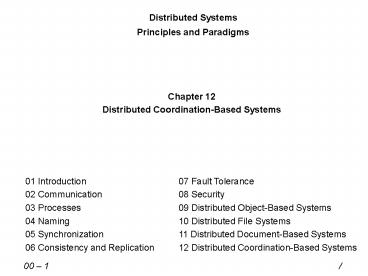Distributed Systems - PowerPoint PPT Presentation
Title:
Distributed Systems
Description:
09 Distributed Object-Based Systems. 10 Distributed File Systems ... a man-in-the-middle attack (Chuck pretending to be Bob to Alice, and Alice to Bob) ... – PowerPoint PPT presentation
Number of Views:77
Avg rating:3.0/5.0
Title: Distributed Systems
1
Distributed Systems Principles and Paradigms
Chapter 12 Distributed Coordination-Based Systems
01 Introduction 02 Communication 03 Processes 04
Naming 05 Synchronization 06 Consistency and
Replication
07 Fault Tolerance 08 Security 09 Distributed
Object-Based Systems 10 Distributed File
Systems 11 Distributed Document-Based Systems 12
Distributed Coordination-Based Systems
00 1 /
2
Distributed Coordination-Based Systems
- Coordination models
- TIB/Rendezvous
- Jini
12 1 Distributed Coordination-Based Systems/
3
Coordination Models
Essence We are trying to separate computation
from coordination coordination deals with all
aspects of communication between processes, as
well as their cooperation. Make a distinction
between Temporal coupling Are
cooperating/communicating processes alive at the
same time? Referential coupling Do
cooperating/communicating processes know each
other explicitly?
12 2 Distributed Coordination-Based
Systems/12.1 Coordination Models
4
TIB/Rendezvous Overview
- Coordination model makes use of subject-based
addressing, leading to what is known as a
publish-subscribe architecture - Receiving a message on subject X is possible only
if the receiver had subscribed to X - Publishing a message on subject X, means that the
message is sent to all (currently running)
subscribers to X.
12 3 Distributed Coordination-Based
Systems/12.2 TIB/Rendezvous
5
Overall Architecture
Essence TIB/RV uses multicasting to forward
messages to subscribers. To cross large-scale
networks, it effectively builds an overlay
network with proprietary multicast routers
12 4 Distributed Coordination-Based
Systems/12.2 TIB/Rendezvous
6
Communication Events (1/2)
Events Publish-subscribe systems are ideally
supported by means of events you are notified
when someone publishes a message that is of
interest to you. Listener event local object
that registers a callback for a specific subject.
12 5 Distributed Coordination-Based
Systems/12.2 TIB/Rendezvous
7
Communication Events (2/2)
Event scheduling Events for the same listener
event are handled one after the other they may
also be lost/ignored if listener event is
destroyed at the wrong time
12 6 Distributed Coordination-Based
Systems/12.2 TIB/Rendezvous
8
Naming
Essence Names are important as they form the
address of a message. Filtering facilities
ensure that the right messages reach their
subscribers
Filtering using special wildcards
12 7 Distributed Coordination-Based
Systems/12.2 TIB/Rendezvous
9
Transactional Messaging
Essence Ensure that the messages sent by a
single process are delivered only if the sender
commits ? store published messages until commit
time, and only then make them available to
subscribers Note Transactional messaging is not
the same as a transaction only a single process
is involved.
12 8 Distributed Coordination-Based
Systems/12.2 TIB/Rendezvous
10
Fault Tolerance Multicasting
Problem TIB/RV relies on multicasting for
publishing messages to all subscribers. This
mechanism needs to be extended to wide-area
networks and requires reliable multicasting. Solut
ion Pragmatic General Multicast (PGM) a
NACK-based scheme in which receivers tell the
sender that they are missing something(?no hard
guarantees).
12 9 Distributed Coordination-Based
Systems/12.2 TIB/Rendezvous
11
Fault Tolerance Process Groups
Essence Process resilience is provided through
process groups active members respond to all
incoming messages, inactive ones just
listen. Note If number of active members equals
one, we have a primary-based replication
protocol. Ranking All members are ranked the
TIB/RV ensures (automatically) that the
highest-ranked process is activated when an
active member crashes. Question How can the
middleware guarantee that a specific number of
active members are running?
12 10 Distributed Coordination-Based
Systems/12.2 TIB/Rendezvous
12
Security
Essence Establish a secure channel between a
specific publisher and a specific
subscriber. Question We are losing something in
our coordination model what?
Note The shared secret KA,B is established
through a Diffie-Hellman key exchange. We are now
trying to avoid a man-in-the-middle attack (Chuck
pretending to be Bob to Alice, and Alice to Bob).
12 11 Distributed Coordination-Based
Systems/12.2 TIB/Rendezvous
13
Jini Overview (1/2)
- Coordination model temporal and referential
uncoupling by means of JavaSpaces, a tuple-based
storage system. - A tuple is a typed set of references to objects
- Tuples are stored in serialized, that is,
marshaled form into a JavaSpace - To read a tuple, construct a template, with some
fields left open - Match a template against a tuple through a
field-by-field comparison
12 12 Distributed
Coordination-Based Systems/12.3 Jini
14
Jini Overview (2/2)
Write A copy of a tuple (tuple instance) is
stored in a JavaSpace Read A template is
compared to tuple instances the first match
returns a tuple instance Take A template is
compared to tuple instances the first match
returns a tuple instance and removes the matching
instance from the JavaSpace
12 13 Distributed
Coordination-Based Systems/12.3 Jini
15
Communication Notifications
Essence A process can register itself at an
object to be notified when an event happens. Uses
a callback mechanism through listener objects. A
callback is implemented as an RMI. Note You can
also be notified for matches in a JavaSpace, but
there may be a race
12 14 Distributed
Coordination-Based Systems/12.3 Jini
16
JavaSpace Server (1/2)
Essence A JavaSpace is implemented by means of a
single server it turns out be hard to distribute
and replicate a JavaSpace. Replicated version
12 15 Distributed
Coordination-Based Systems/12.3 Jini
17
JavaSpace Server (2/2)
Distributed version
Scalability Do not replicate, but use different
JavaSpaces leading to nontransparent logical
distributions. Possibly move a JavaSpace to
places where a lot of clients are.
12 16 Distributed
Coordination-Based Systems/12.3 Jini
18
Transactions
Essence Jini provides only a standard interface
to a 2PC protocol. It offers a default
implementation for this protocol.
Question What good will it do if you only
provide interfaces?
12 17 Distributed
Coordination-Based Systems/12.3 Jini
19
Comparison
12 18 Distributed
Coordination-Based Systems/12.3 Jini































